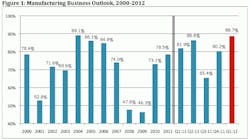Much has been made of the recent resurgence in manufacturing activity. After much slower growth in the middle of 2011, production started to pick up again around October or November. This coincides with manufacturers and the public becoming cautiously more confident in the economy overall, despite a number of persistent headwinds.
This also was evident in thelast NAM/IndustryWeek Survey of Manufacturers released in December. The percentage of manufacturers who were either somewhat or very positive about their business outlook jumped to 80%, up from 65% in the September survey. Americans had become anxious with developments in Europe, the downgrading of the U.S. credit rating, persistent challenges in the labor and housing markets, and tax and regulatory uncertainties. Indeed, the September figure which had plummeted 20 points in just three months mirrored many other sentiment surveys at the time. As confidence started building, business activity increased, new employees were added and consumers began spending again.
The outlook for growth this year improved with the revival in optimism at the end of last year. I am currently predicting 2.6% growth in real GDP in 2012, which is in line with other estimates. Even with slower growth in the middle of last year, industrial production is up 3.4% in the last year and 9.3% in the last two years. In addition, manufacturers have added 111,000 net new jobs in the past three months, or 425,000 since December 2009. Sentiment surveys suggest higher activity in the coming months as well.
- "Demand by our customer base to reduce selling price due to international competition." (primary metals or fabricated metal products)
- "No talent available. We are all going after the same people." (machinery)
- "Threat of war with Iran; European debt crisis; general uncertainty throughout the world with regard to political issues." (computer and electronic products)
- "EPA, EPA, EPA." (chemicals)
- "Lack of clarity regarding future federal tax policy, regulation and health care mandates." (miscellaneous manufacturing)
- "Health insurance costs and mandates (up 100% in the last two years)." (food manufacturing)
- "Can't go over 50 employees because then medical insurance will be unaffordable. We are at 49 employees now." (primary metals or fabricated metal products)
- "Reducing training costs by drawing from a trained pool of people. Currently we have hired 140 people since 2009 and another 25 people will be added in 2012. We will interview 150 to get 25. Most do not have the basic foundation to enter the manufacturing workforce nor can they pass a drug screen." (primary metals or fabricated metal products)
- "European economic crisis and its possible domino effect." (electrical equipment and appliances)
- "General inflation in cost of virtually all overhead items." (wood products)
- "Cuts in Defense Dept. budgets." (apparel and allied products)
- "Health insurance costs are a huge issue for profitability." (transportation equipment)



